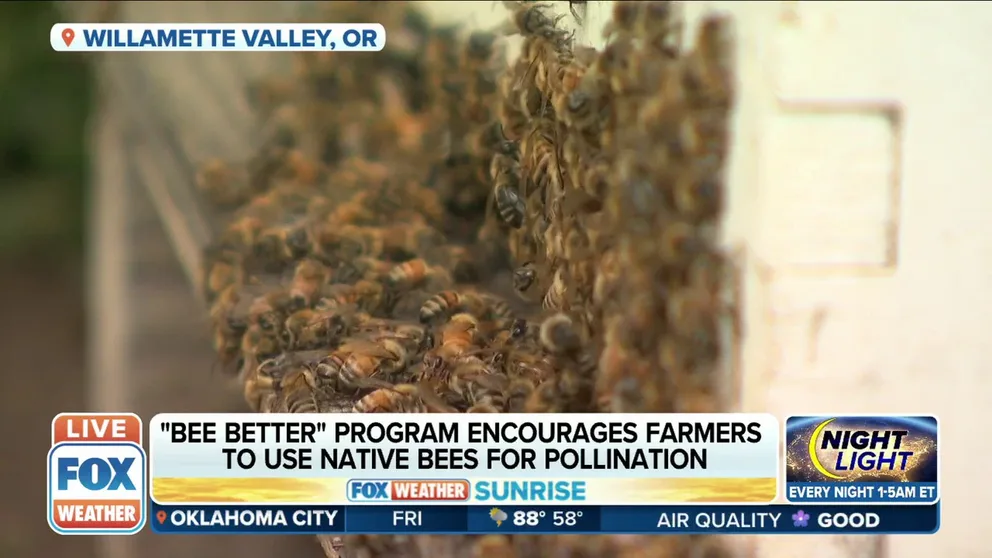Where is the western bumblebee? The super-pollinator declined 57% in 2 decades, study said
The USGS completed a study showing a 57% decline of the once-common generalist pollinator. The U.S. Fish and Wildlife Service is taking this research under consideration and could list the bee 'endangered.'
Native bumblebees face extinction
FOX Weather's Max Gorden found a farmer changing the way he does business to prevent the America's bumblebees from going extinct.
Fields of flowers, picnics and bumblebees were synonymous with summers. Recent research shows one of those items is quickly disappearing. And it is not just the summer of our childhoods that is at risk, scientists fear an eventual reduction of fruits, seeds and nuts that feed not only wildlife but humans too.
Research suggests drought, increasing temperatures and insecticide use is to blame.
The once common western bumblebee buzzed in great numbers from Arizona and New Mexico to Yellowstone and beyond to Canada then across the Rockies to the coast. Scientists noticed a drop-off though. Research shows a 57% decline in just 23 years.
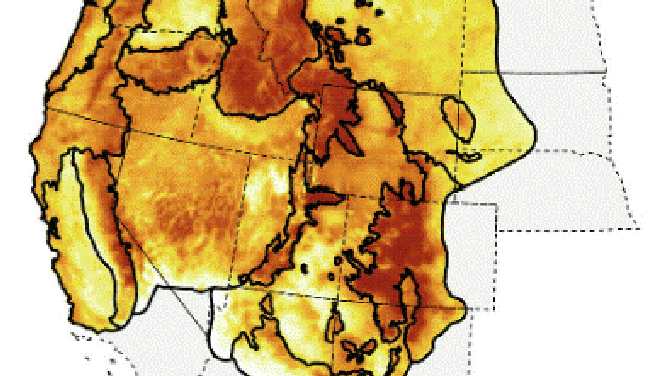
Surveys in 1998 found the western bumblebee 100% of the time in the darkest orange, 50% in the light orange and 0% in white shaded areas.
(USDA, Janousek, Graves, et al / FOX Weather)
What does a 57% decline mean?
"To put that 57% decline in perspective, 1998, if you were to go to ten random locations, you would expect to find the species in five of those," said U.S. Geological Survey biologist and co-lead author of the study, Will Janousek. "And in 2020, you would expect to see those species in two of the ten locations."
"We did this study to track how big of changes have occurred and what are some of the biggest factors driving that change?" continued Janousek.
PROTECT LOCAL BEES: ‘NO MOW MAY’ – NOT LAZY, JUST SAVING THE BEES
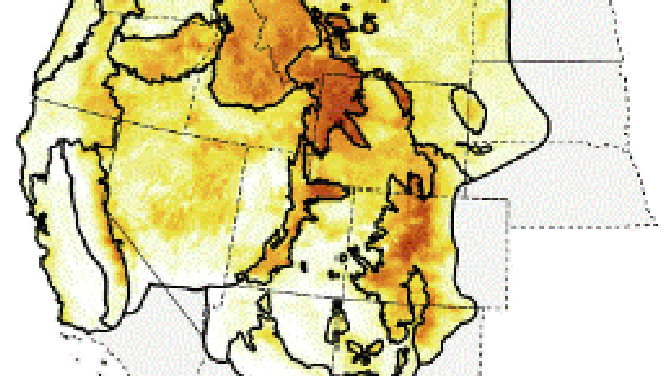
Surveys in 2020 found the western bumblebee 100% of the time in the darkest orange, 50% in the light orange and 0% in white shaded areas.
(USDA, Janousek, Graves, Et Al / FOX Weather)
The study examined both severity and length of drought, increase in precipitation, warmer temperatures and neonicotinoids pesticide use in relation to the observation or occurrence of the bees over time.
He and his colleagues then looked at 3 different scenarios of changes in climate and land cover for 2050. In the most optimistic case, which factored in the least amount of climate and land use changes, the bee occurrences further declined in half of the geological or ecoregions. Only higher altitude bumblebee strongholds like Yellowstone maintained the current level.
PESTICIDE-FREE MILKWEED FOR BUTTERFLY GARDENS MAY BE HARD TO FIND AT NURSERIES, NEW STUDY FINDS
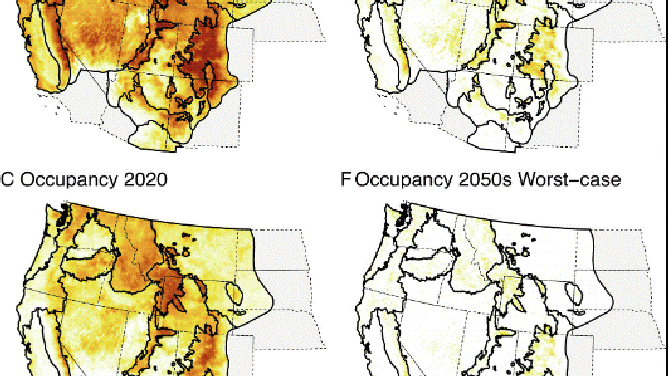
Survey results on the left are from 1998 at top and 2020 on the bottom showing the western bumblebee occupancy 100% of the time in the darkest orange, 50% in the light orange and 0% in white shaded areas. The left side shows the 2020 scenarios on the right. The top is the middle-case and the bottom is the worst case.
(USDA, Janousek, Graves, Et Al / FOX Weather)
"Under that worst case scenario we see the most change in, the occurrence of the species. We find is greater than 85% decline across the former range," continued Janousek.
The fuzzy yellow and black bee with a white spot on its butt is not alone.
HOW TO WATCH FOX WEATHER ON TV
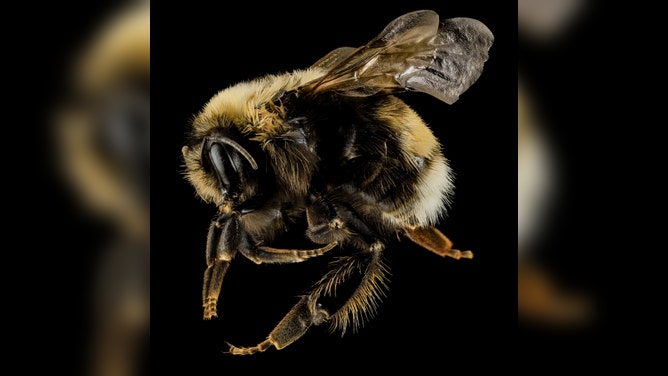
The western bumblebee has almost entirely disappeared from its West Coast range.
(USGSBIML Team, Public domain / FOX Weather)
Pollinators becoming scarce worldwide
"Here in the U.S., we have about 3,600 species of native bees, and somewhere around a quarter of those are facing extinction," said Liz Robertson of the Xerces Society, a conservation group.
A United Nations-sponsored report claimed that almost 40% of pollinating insects worldwide face extinction.
"And it's not just bumblebees. We see declines in other species groups like butterflies, birds and bats even. So this is kind of a pattern that we've observed across species and across locations around the globe" Janousek said.
TRACK THE PROGRESS OF SPRING THOROUGH LEAF PRODUCTION

USGS biologist and co-lead author to the study, Tabitha Graves, collects western bumblebee samples in eastern Montana.
Janousek said 2 other bumblebee species were already listed as endangered in the Endangered Species Act. And several others are being considered.
"This species in particular has been petitioned for consideration of being listed under the Endangered Species Act, either threatened or endangered," said Janousek. "The Fish and Wildlife Service makes those determinations, and they're going through a process to evaluate the species for listing. And our role in the study is to provide the science to help support their decision-making."
Why are pollinators crucial?
About 85% of flowering plants require pollination. Pollinators as a group provide a $1.5 billion service in the U.S. alone. About 75% of food crops are insect pollinated, said Matthew Sheppard of the Xerces Society. In a decree, the Senate said that that pollinators are responsible for one of every three bites of food consumed in the U.S.
WHY WE SHOULD THANK A BEE FOR DINNER
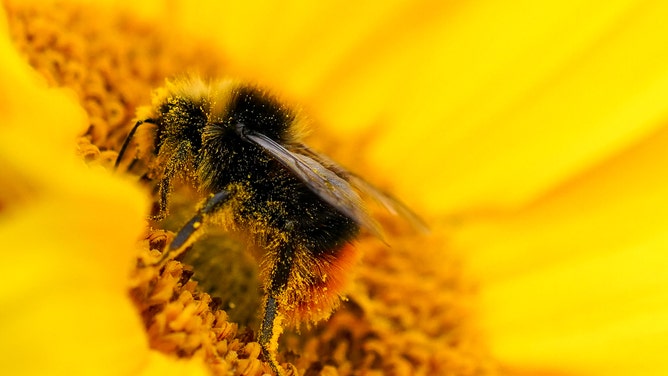
A native bumblebee is covered with pollen from a sunflower while extracting nectar. The bee will go to another flower for more nectar and drop pollen from the first flower, pollinating flower two so it is ready to produce seeds.
(Jacob King/PA Images via Getty Images / Getty Images)
"We don't know exactly the contributions of any individual pollinator to that system or to that cycle.," said Janousek "Pollinators act as, kind of that middleman, transferring resources from plants to other wildlife."
The study published in the Proceedings of the National Academy of Sciences stated that, "pollinators provide a critical ecosystem function, create the foundation of terrestrial food webs, and serve as a linchpin to cascading effects across species."
"Pollinators also support food webs by serving as food for insectivorous birds and lizards and other arthropods such as dragonflies, ants, and spiders," the study said. "Losing even a single common pollinator species can disrupt the entire pollinator networks, with abrupt consequences for the species that directly or indirectly rely on them for food, including humans."

Bees pollinate 85% of flowering plants including fruit and nuts.
(Xerces Society / FOX Weather)
The decline of a generalist pollinator, like the western bumblebee that pollinates a wide range of species, is a "bellwether loss," said the researchers.
The strongest influences on the western bumblebees' numbers were increasing summer temperatures and drought from the period between 1998-2020.
"Bumblebees are pretty well suited for colder temperatures. They can get heat stress easily, and that heat stress can lead to mortality," Janousek said. "So hotter temps can kill the bees directly, but also when it tends to get hotter out, they don't forage as often. And so they might not be able to access food as readily."
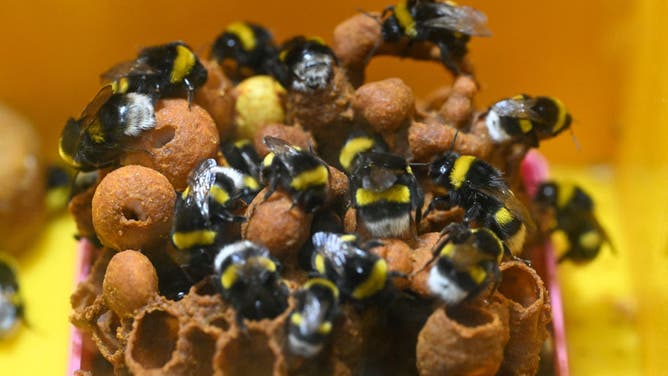
File: This is a file photo of a cousin to the western bumblebee working in a hive in a lab.
(Ozkan Bilgin/Anadolu Agency / FOX Weather)
He said even warm winter temperatures are a problem. Those warmer temperatures can wake bees up from "essentially hibernating." They use energy but can’t forage on flowers which haven’t bloomed yet.
The group used climate models and emissions scenarios to extrapolate declines to 2050 Janousek said. Running models on different land cover scenarios enabled the scientists to other factors like future pesticide use and disease outbreak. He said the most optimistic or best case scenario assumed regulators mitigated the negative effects of factors like pesticide and disease.

USGS biologist and co-lead author to the study, Tabitha Graves, collects western bumble bee samples in eastern Montana.
(USDA, Janousek, Graves, Et Al / FOX Weather)
Everyone can help: Citizen scientists wanted
Janousek said that this research would not have been possible without citizen scientists. Observing bees over 23 years took a lot of manpower.
"We had a little over 14,500 surveys on this. And, a good portion of that is from citizen science," said Janousek. "There's a large collaborative effort that involved both federal and state agencies, universities, collections, but also folks in their backyards. So I think it's important to know that people can contribute to this type of science by making observations in their backyard and submitting it."
The Xerces Society connects volunteers to community science projects. Local Cooperative Extension Offices may also have more information about projects in your area led by universities and the USDA..
